This was published 8 years ago
Poland, Eastern Europe: Why Poland is Europe's next big thing
One eastern European treasure remains largely undiscovered, writes Ute Junker.
By Ute Junker
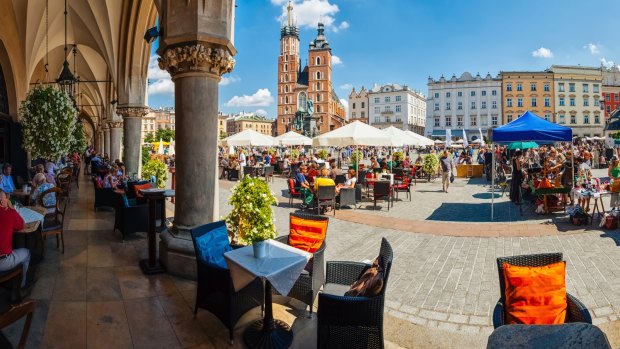
Main market square of Krakow.Credit: iStock
Travel is all about timing. If you have ever been tempted by the fabled wonders of Syria, for instance – the souks of Aleppo, the ancient ruins at Palmyra, the mighty walls of Krak des Chevaliers – then clearly you have missed your moment.
As some destinations become no-go zones, however, others move centre-stage. Take eastern Europe. Once hidden behind the Iron Curtain, dazzling destinations such as the stone streets of Dubrovnik, the canals of St Petersburg and the imperial elegance of Prague and Budapest have cemented their place in the tourist brochures.
One eastern European treasure, however, remains largely undiscovered. For some reason, Poland has remained off the radar of all but the most intrepid travellers. Unlike its neighbours, which have shed their grim Soviet-era reputations, Poland seems unable to shake the ghosts of its tragic past.
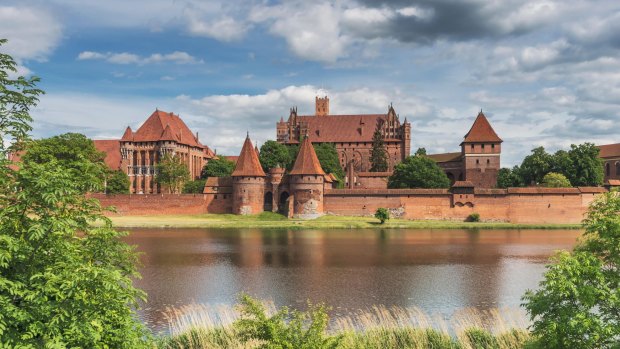
Castle of the Teutonic Order in Malbork, Poland on the river Nogat.Credit: Alamy
There is no denying its dark history. The country that was once the largest in Europe has been invaded time and again, by Germans, Russians, Tatars, Ukrainians, Cossacks, Ottomans and Swedes. In the 18th century, it disappeared altogether, partitioned between Austria, Russia and Prussia.
During World War II, Poland was invaded by both the Nazis and the Soviets, with the former establishing their network of death camps on Polish soil. The end of the war brought no relief. The Iron Curtain descended on Poland, not to lift again until the tumultuous days of 1990, when the fragmenting Communist Party of Poland took the unprecedented step of dissolving itself.
Throughout their turbulent history, the Poles have demonstrated remarkable resilience. Today, they are turning to the task of reinventing themselves as a tourist destination. With a profusion of medieval towns, mighty castles and an unspoiled countryside, there is enough to keep even the most energetic visitor busy. So take a look through our selection of highlights, and discover why Poland is Europe's next big thing.
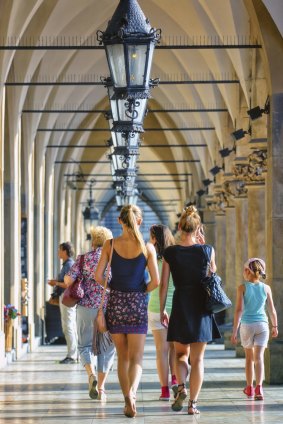
Enjoy the Renaissance architecture of the Cloth Hall in Market Square, Krakow.Credit: Getty Images
KRAKOW: OLD-SCHOOL ELEGANCE
With spires and turrets soaring into the sky, cobbled streets and ornate facades, Krakow delivers old-school elegance at every turn. It's the European city that Walt Disney might have designed, right down to the castle atop the hill. Although there is no sleeping princess in residence, in the cathedral next door the kings of Poland are enjoying their eternal slumber entombed in red marble.
There is nothing sleepy about the city itself. Don't let the picturebook prettiness of the Rynek Głowny, or main square, fool you. Take a seat in one of the al fresco cafes and watch the tide of locals eddying around its spectacular buildings – the ornate St Mary's Church with its stunning carved wooden altarpiece, or the gorgeous Renaissance Cloth Hall – and you'll realise this is a vibrant, living city, not an outdoor museum.
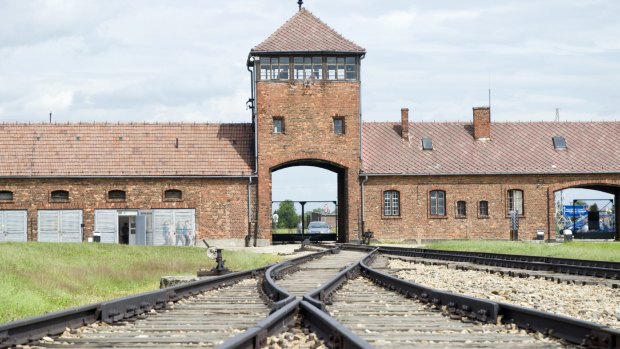
The entrance to the notorious Auschwitz-Birkenau concentration camp in Poland.Credit: iStock
Or, perhaps, it is a bit of both. Take the former Jewish district of Kazimierz, which has scored a World Heritage listing for its intact streetscape. Those streets featured heavily in the film Schindler's List; however, once the cameras disappeared, the historic buildings returned to their everyday function, housing many of Krakow's best-loved bars and restaurants.
MALBORK: HOME OF THE TEUTONIC KNIGHTS
They don't get as much press as their fellow warrior monks, the Knights Templar, but the German Teutonic Knights were one of the medieval world's most formidable fighting forces. At Malbork, south of Gdansk, they built a mighty headquarters – the largest Gothic brick castle in Europe – that still awes today. Malbork was designed to be impregnable, and for centuries repulsed every enemy attack; between the inner moat and the central courtyard alone stood seven massive gates.
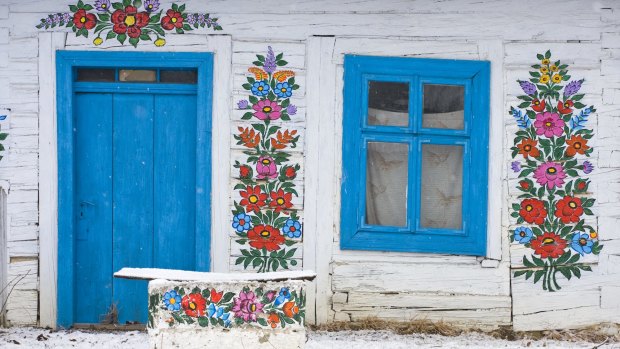
Floral folk decoration on a house in Zalipie, Poland.Credit: iStock
The knights were not just ruthless warriors but also canny investors. Thanks to their monopoly on the amber trade, they grew so wealthy that they were able to lend money to kings. They clearly reinvested some of the profits in their headquarters, which boasts not just beautiful interiors, but also modern conveniences such as underfloor heating and a lift that sped food from the kitchen to the tables.
The knights apparently enjoyed entertaining – the castle has 400 guest rooms – but they took nothing on trust. Look carefully at the portrait in the banqueting hall, and you will see it has empty eye sockets, allowing the knights to observe their guests without being seen.
ZAKOPANE: DOWN TO THE WOODS
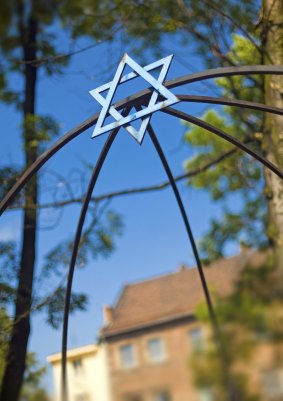
Jewish Star in a courtyard on Szeroka in Jewish Kazimierz Quarter, Krakow.Credit: Elan Fleisher
In fairytales, the woods are always dark and threatening. In Poland's Tatra Mountains, however, the leafy forests are wonderfully inviting. Skiers flock here in winter to test themselves on the slopes; we prefer to visit in summer, when the quiet paths meandering through the trees tempt you to lace up your hiking boots. Allegedly there are still bears and lynx lurking in the quieter reaches of the woods, but we are assured it is rare for visitors to encounter them.
The lovely town of Zakopane, ringed by high peaks, has been popular with holidaymakers for centuries. Its idyllic natural setting and traditional lifestyles inspired Polish artists, writers and composers. Even today, the area gives you a glimpse of an earlier Poland, particularly the wooden houses that dot the area, carved with pretty floral motifs and made without metal nails. Music lovers should try to catch a performance of the area's distinctive Goral music, a tradition that is still alive and well.
GDANSK: FROM REVOLUTION TO RESTORATION
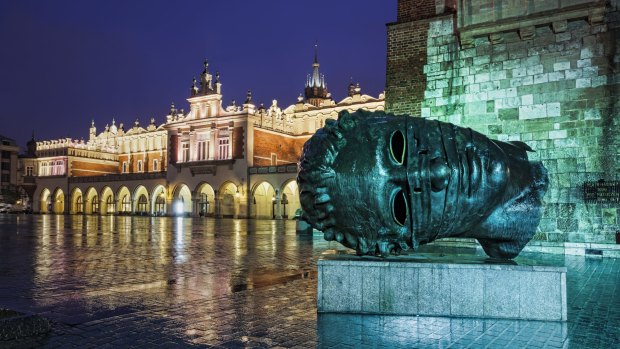
A corner of the Rynek Glowny, the main square in Krakow.Credit: Getty Images
The Kardashians aren't the only ones who know a thing or two about makeovers. Back in the 1980s, when Lech Walesa's Solidarity movement made global headlines, Gdansk seemed a pretty grim place. These days it is one of Europe's most gorgeous cities, its rebuilt and restored buildings bearing witness to its days as one of the continent's busiest ports.
Medieval Gdansk was a trading city, and the merchants who ran it knew that first impressions count. That is why they constructed what is still one of the grandest streets in Europe: Długi Targ, or Long Market. From the Golden Gate at the top of the street to the Green Gate which opens onto the river, every building is extraordinary. Painted green and purple, crimson and ochre, decorated with frescoes and flanked by lions, the gabled structures present one gorgeous facade after another.
Gdansk's most famous landmarks include the magnificent Neptune fountain, the stunning guildhall known as the Artus Court, and a clutch of mighty medieval red brick churches. St Mary's Basilica alone is home to treasures including a 15th century astronomical clock, Hans Memling's painting of The Last Judgment, and a flock of Euterpean angels.
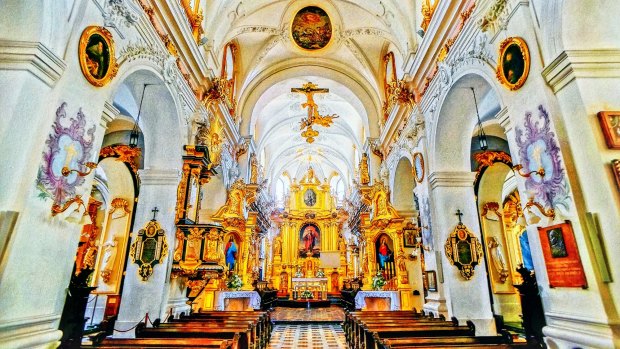
The Collegiate church of St. Florian, KrakowCredit: Wendy Rauw Photography
AUSCHWITZ: A SITE OF HORROR
Some places need no introduction, and the site of one of the greatest mass murders in history is one of them. Auschwitz, the Nazi extermination camp where hundreds of thousands of Jews – and others including Polish resistors, Roma and Soviet prisoners of war – met their deaths is a place of such horror, some travellers might be tempted to give it a miss.
However, many thousands do choose to visit Auschwitz every year, to learn, to remember and to realise where hatred can take you. The guided tour spares no details of the horrifying stories, from the gassings to the medical experimentation. However, what is most moving – at least, for me and some of my companions – is the belongings of the dead, on display in heartbreaking masses.
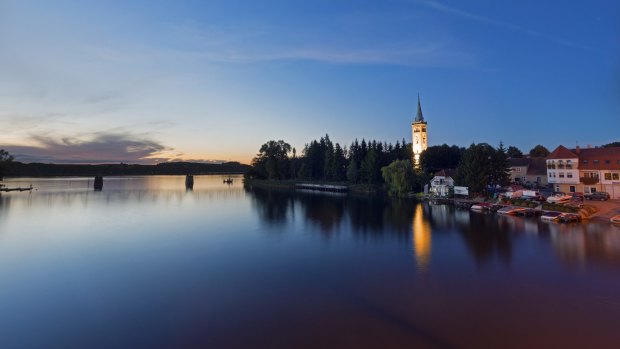
The forest-fringed Masurian Lakes are a delightful summer playground. Credit: Christian Kober/ John Warburton
Looking at the more than 100,000 pairs of worn shoes, or the thousands of suitcases – large and small, battered or nearly new – brings home the fact that behind the statistic were millions of ordinary people, each with their own story, which came to an abrupt end here.
THE MASURIAN LAKES: FROM HAVEN TO HITLER
Whether you are a serious sailor or just enjoy a spot of kayaking, the forest-fringed Masurian Lakes are a delightful summer playground. At its heart lies the massive Lake Sniardwy; a series of canals and rivers links it with other canals and waterways. The areas not covered by lakes or forests are home to rolling farmland and pretty little towns.
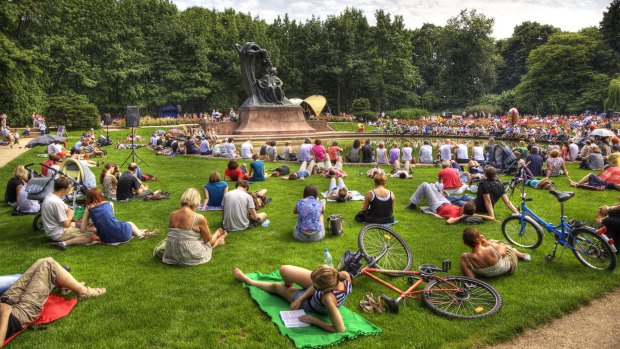
Lazienki Park in Warsaw.Credit: Getty Images
During July and August, holidaymakers throng here; the rest of the time, it is much more laidback. The most popular towns include Węgorzewo and Gizycko, the latter being known for its remarkable rotary bridge, dating back to 1889, which is opened by hand six times a day to allow boats through.
If you are keen to go further afield, the town of Ketrzyn makes a good base. Like many of the local towns, Ketrzyn was founded by the Teutonic Knights; its sheltering castle still stands. From here you can explore the medieval town of Reszel, as well as the area's darkest relic: the partly destroyed concrete bunkers that are all that remain of Hitler's World War II headquarters, the Wolfsschanze.
WIELICZKA SALT MINE: THE WONDER UNDERGROUND
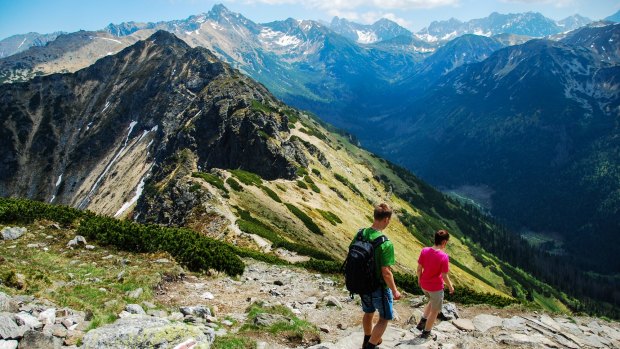
Paths meander through mountains in Poland.Credit: Karol Majewski
When is a salt mine not a salt mine? When it is both one of the country's oldest enterprises, and one of its biggest tourist attractions. The Wieliczka Salt Mine is officially 900 years old, but the site was already being mined in ancient times. During the Renaissance, it was one of the largest businesses in Europe; by the 18th century, it was already becoming a tourist attraction.
Mining ceased in the 1990s, but these days the mine is busier than ever before. Over a million visitors every year descend 135 metres into the earth and are led through kilometres of labyrinthine tunnels.
Most are startled by what they find: underground lakes, and reliefs, monuments and even salt-crystal chandeliers, all patiently carved out by the miners. For those with a more industrial bent, a Miners' Route is also available, which offers insights into the tasks, traditions and workings of a functioning mine.
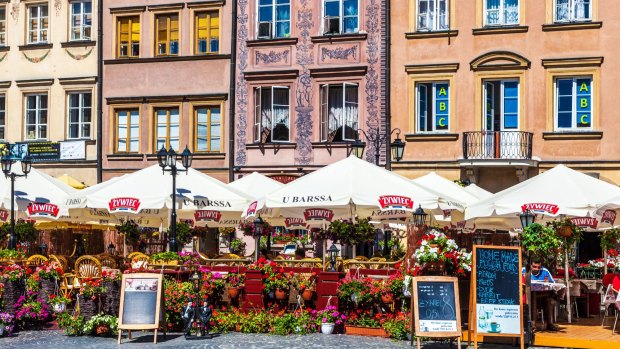
Outdoor bars and restaurants in Stary Rynek, Old Town Market Place in Warsaw, Poland.Credit: Alamy
WROCLAW: SLEEPING BEAUTY
Don't fall for Wrocław's claim to be "the Venice of Poland". Yes, the city's riverside areas are lovely for strolling, the shores lined with ornate manors and verdant parklands, while more than 100 bridges span the calm water. Venice, however, it ain't.
Still, you can't blame the locals for trying to get some attention. Provincial cities such as Wrocław and Torun get little attention from tourists, which is a shame when they are this beautiful.
At Wrocław's heart lies a beautiful – and vast – market square; a stroll through the surrounding streets takes you past everything from Gothic churches and Renaissance tenements to ancient fortifications and Belle Epoque department stores. In fact, Wrocław is so packed with gems that the "introductory walk" suggested by one reputable travel guide takes around five hours.
The city's diverse influence reflects the many cultures that once made their home here: Czechs and Hungarians, Italians, Germans and Jews. Today, a large student population keeps things lively, as does one of the best contemporary art scenes in the country, where the galleries – housed in everything from former monasteries to repurposed air raid shelters – are almost as intriguing as the works on display.
WARSAW: THE SURVIVOR
If Poland's biggest city feels a little rough around the edges, it has reason to. Since it became Poland's capital four centuries ago, it has been invaded by pretty much any country with an army, including the Swedes. In the last days of World War II, the brave locals launched the Warsaw Uprising, the biggest resistance action ever undertaken against the Nazis, and saw their city destroyed in retaliation.
In just two months, the Nazis razed the city, killing 200,000 locals in the process. The retreat of the Nazis brought no relief – Soviet troops were quick to move in and occupy the devastated city.
However, Warsaw is a survivor, and even amid the unlovely Soviet-style architecture, echoes of earlier times remain. Today, locals stroll along the lovely Nowy Swiat boulevard or enjoy Chopin concerts in Lazienki Park, just as their forebears did, or head for the al fresco bars lining the banks of the Vistula river. Warsaw even has its own burgeoning hipster scene in Praga, where former warehouses and factories are being converted into galleries, bars and other hip hangouts.
OFF-BEAT POLAND
SKULLS AND BONES In a macabre mood? Then head to the church of Kaplica Czaszek in the small town of Czermna, where the interiors are decorated with the skulls and bones of over 3000 people. The 18th century priest in charge of the decoration also stored a further 21,000 skeletons in the church crypt.
LOCAL HERO It doesn't take long to realise that Poland's greatest local hero is John Paul II. There are plenty of monuments to the pope – including a series of stained glass windows in a church at Zakopane – but none are as striking as the 14-metre-high statue in the town of Czestochowa.
FLOWER POWER They don't go for minimalism in Zalipie. This village is known throughout Poland for the local habit of painting intricate floral patterns on every surface. Once upon a time, they had to make their own paints out of cooking fat and dye; these days, they use the real stuff.
DRAGON'S DEN Ever set foot in a dragon's den? At Krakow Castle, you can. According to legend, a series of caverns beneath the castle once housed a fearsome dragon that terrorised the town; in medieval days, the caves were variously used as a tavern and a brothel.
BODY WORK With its elegant Renaissance buildings, Zamosc feels like a slice of Italy transported to Poland, which is exactly the effect the town's founder, Jan Zamoyski, was after. It's not just the architecture that makes this town unique, but also its layout: it mimics the shape of a human body, with the palace as its head and Grodzka Street as its spine.
FIVE MORE FORMER COMMUNIST DESTINATIONS
ROMANIA Romania's capital, Bucharest, is a love-it-or-hate it place, but the Carpathian Mountains are irresistible. Hiking through forests and meadows, visit grand medieval fortifications such as Corvin Castle, or just chill out in pretty towns such as Brasov.
LATVIA There is only one real city in Latvia, but it's a beauty. The buildings lining Riga's cobblestone streets range from Gothic marvels to ornate art nouveau confections. Further afield, the Kurzeme region, which has both white sand beaches and medieval towns, is a popular destination.
SLOVENIA Slovenia packs plenty of Instagrammable attractions into its modest area. From the Venetian-influenced towns of the Adriatic coast to the sparkling lakes and jutting peaks of the Julian Alps, there is much to discover. Leave a couple of days to explore its pretty-as-a-picture capital, Ljubljana.
BULGARIA Bulgaria's attractions include Thracian tombs, Roman amphitheatres and monasteries glittering with mosaics. Highlights of any itinerary include the medieval capital of Veliko Tornovo, the modern capital of Sofia, and the charming university town of Plovdic.
RUSSIA Beyond majestic Moscow and romantic St Petersburg, Russia's more remote regions have plenty to tempt visitors, from the geysers and volcanoes of Kamchatka to the beauty of Siberia's forests and the mighty Lake Baikal.
TRIP NOTES
MORE INFORMATION
GETTING THERE
Emirates operates 77 flights per week from Australia to Dubai, with a daily onwards connection to Warsaw. From there, internal flights connect with cities such as Krakow, Gdansk and Wroclaw. For flight information and bookings, contact Emirates on 1300 303 777, visit your local travel agent or go to www.www.emirates.com/au
TOURING THERE
Insight Vacations' 10-day Highlights of Poland takes in Krakow, Zakopane, Auschwitz, Wroclaw, Gdansk, Malbork Castle and Warsaw. Prices start from $2450. See www.insightvacations.com.au.
Ute Junker travelled as a guest of Insight Vacations.
Sign up for the Traveller Deals newsletter
Get exclusive travel deals delivered straight to your inbox. Sign up now.